This December, we’re taking a trip back in time to review the ninth season of The X-Files.
Nothing like cancellation to get the vultures circling.
It is the nature of television that not every episode ends up exactly the way that the production team would like. Working on a tight deadline with a limited budget, compromises have to be made. Sometimes, there is not enough time to properly polish a script so that it makes sense. Other times, the special effects have to be rushed. Churning out twenty-odd episodes in a season demands a lot of the production team, and it seems impossible to maintain a perfect record across a full season.

Skull and bones…
The X-Files might have held itself to the highest production standards, but there are inevitable missteps along the way. Fearful Symmetry is about invisible zoo animals because there is no way that the show could be about visible zoo animals. Teso dos Bichos had difficulty wrangling its cats. The special effects work on Tunguska came so close to the wire that people in different parts of the country actually saw different cuts of the episode. Parts of Christmas Carol had to be reshot when the child actor proved unreliable in Emily.
These are the realities of television production. It is not always pretty, and the result is not always fantastic, but it gets done. Fans and commentators have a tendency to overlook these problems when they occur at the height of the show. They are less forgiving when they occur past the show’s prime.

Crosses to bare…
Underneath is not a good episode of television. It is barely a competent episode of television. It is not an offensive episode of television. It feels like a throwback to the first season of The X-Files, when it seemed like nobody working on staff had any clear idea of what the show was supposed to be about, so maybe they could write a generic police procedural script and throw in some weird paranormal stuff along with a spurious link to the past of one of the main characters. Add some jump scares, try to make it personal, move on to the next script.
The biggest problem with Underneath is that it feels bland and forgettable. That is a shame, given that it features a guest performance from veteran character actor W. Earl Brown who was seemingly cast on the strength of his work in There’s Something About Mary. Underneath is very much of a piece with Shadows, Lazarus and Born Again. It is a perfectly serviceable episode of television that makes for perfect viewing while lounging on the couch and wanting to catch some shut eye. It is not an offense against nature, but it is nothing to write home about.
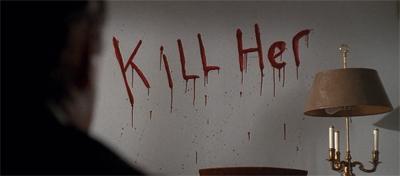
If walls could talk…
Of course, all those bland and generic first season episodes had the luxury of airing before The X-Files became a bona fides cultural phenomenon, and certainly before the series had become a television institution, and most definitely before it was cancelled after an impressive nine-season run on prime-time television. Context tends to change the way that these failures are received. If Underneath had aired in the early seasons, it would be excused as the show finding its feet. If Underneath had aired at the show’s peak, it would be an “off” week.
However, Underneath had the misfortune of airing at a point where the show was at its lowest ebb. The ratings had been in decline. The fanbase was baying for blood. The media were eager to demonstrate how a once-beloved show had fallen from grace. The series had even been cancelled, even if Underneath had been produced before the cancellation had been decided. As a result, the production problems on Underneath found themselves elevated. The episode was not so much put under a microscope as it was thrown into a spotlight.
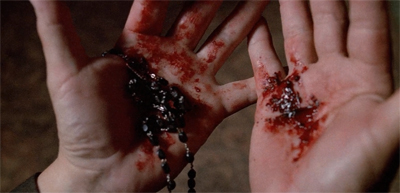
Blood on his hands…
Most (in)famously, anonymous sources emerged from the woodwork to lambast the episode, with Cinescape offering one such inside account of difficulties behind the scenes:
“[Underneath] was pulled from the schedule because FOX had a lot of problems with it — quality problems. It was bad. I mean B-A-D, really bad, like Lord Of The Flies bad. This was a solo John Shiban script and word is that he was pretty much left to his own devices for it. He directed it too. But it was written at the time in between season nine preparations and Chris Carter’s re-arrival, so Carter wasn’t on the scene when it was written and even though he did a rough re-write it was pretty much left of the scrap heap. The first cut was reportedly incomprehensible. I think I saw the second or third cut, and it was a little better. Not really insulting or bad — just boring. It was like a season one Millennium episode, except for the fact that that show was comparatively Oscar material. Underneath is just plain silly. Parts of it reminded me of your basic run of the mill B-grade slasher horror flick. Like Valentine or Urban Legends, minus the mask. They try to give us some insight into Doggett’s past as a NYC cop but it just falls flat — there’s no real meat there. It’s all just facts and figures and no emotional involvement. The killer is boring, we’ve seen the “escaped killer goes after his captor” routine before. But aside from Shiban’s typically poor writing (he did have some good eps like SR 819 and yeah I liked Badlaa — but the bad far outweigh the good) his directing is shocking. I mean really bad. They had to order more re-shoot time than is usually allocated because there were a lot of shots and set-ups that Shiban just didn’t get. Like I said, the cut that I saw was hard to follow…you’d see poorly set-up shots of Doggett walking around a corner and then he’d walk around again…you know, really bad continuity between shots. The lighting was very good, though, except for the confrontation with the killer where it lost something. But I will tell you that it was so hard to follow and so badly directed that the network ordered for it to be re-worked into something a little different, more ‘basic’ and streamlined. We’ll see how it turns out. But that might give you some idea as to why there have been so many scheduling problems with it.”
Chris Carter officially returned for the ninth season in July 2001. If John Shiban had been working on Underneath since then, the episode was in production for eight months. Even its production code suggests it was pushed back.
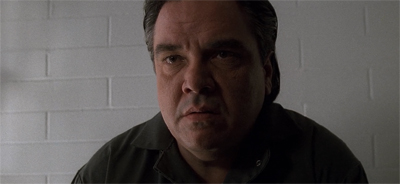
Tough cell…
This was all in the context of other reported conflicts behind the scenes between Fox and Ten Thirteen. As Tom Kessenich reported in eXaminations:
With viewers tuning out in droves, sources said Fox execs became more involved in the show’s content and direction. Underneath had so many problems Fox seriously considered pulling it completely before finally allowing it to be aired later in the season.
“Carter didn’t have to pitch stories since Season 1, so he was upset by having to do that,” one source said. “Spotnitz didn’t even know they had to do that, so he was upset by it. Carter and Spotnitz had their way for so long they couldn’t imagine being accountable to anyone. They thought they were fighting for their show, but Fox just wanted to make sure the shows made sense because they were the ones paying for it.”
A lot of this amounts to “he said, she said” gossip, but it provides a nice context for the larger discourse around the ninth season. There was a lot of anger and frustration, looking for an excuse to manifest.

He hasn’t a prayer…
Fandom is an interesting thing. The X-Files owed its fanbase a lot; those early internet-savvy fans had been crucial in raising awareness of the show and generating buzz around it. The X-Files had truly been one of the first shows to embrace the possibility on on-line fandom, and to harness it. The production team often seemed to tease and play with those fans, as if engaging in a discussion rather than simply delivering a statement. Writers like Glen Morgan and James Wong would even navigate the fan message boards, while Frank Spotnitz and Chris Carter did web chats.
It could be argued that The X-Files helped to define modern internet fandom, particularly the way that fans talk about (and engage with) their favourite shows. Star Trek fandom is undoubtedly an older institution with a similar on-line presence, but The X-Files fandom was very much a product of the late nineties into the twenty-first century. A lot of modern television fandoms – from Doctor Who to Sherlock to Supernatural – owe at least as much to The X-Files as they do to Star Trek.
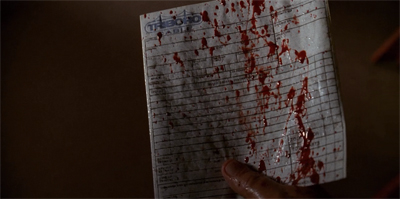
A bloody mess…
As with the Star Trek fanbase, that on-line X-Files fandom would prove to be something of a double-edged sword. Fandom had been essential to establishing The X-Files as a modern television landmark during those first few seasons, but it also demanded a lot of the show. It seemed like the fandom had a higher emotional investment in the show than most contemporaneous television fans. These fans had a very strong idea of what they wanted the show to be, and its failure to conform to those expectations was a source of frustration and anger.
The ninth season was a troubled time for the show, but it seemed as if the fanbase was eagerly participating in the muckracking rather than trying to prevent it. Mainstream media publications like Entertainment Weekly were eager to quote fan complaints like “it’s like the writers no longer care about producing a quality product” as though they were objective fact, while The San Francisco Chronicle was readily comparing Chris Carter to P.T. Barnam. In many ways, the reaction to the ninth season seemed to predict twenty-first century outrage culture.
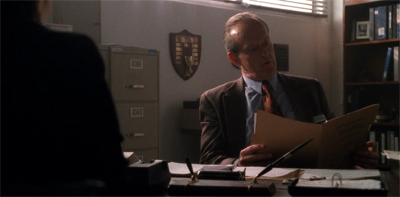
“I know it’s a mystery how this made it to production, but did you have to put the script in a case file?”
The X-Files is not alone in this regard. Star Trek fandom was similarly engaged in its own angry and frustrated self-destructive cycle. Star Trek: Voyager and Star Trek: Enterprise had not been well-received by fans, to the point where angry fans were mailing garbage to Paramount. Internet forums and newsgroups became home to toxic chatter about Rick Berman and Brannon Braga. When Star Trek: Nemesis failed to set the box office alight, the mainstream media joined in. Reading the internet, it seems like nobody enjoyed any twenty-first century Star Trek.
Navigating pop cultural coverage on the internet often feels like an attempt to walk across a minefield. Internet fandom seems perfectly ready to rebel at the drop of the hat, complaining that once-beloved property is not as good as it once was and has become an aberration against nature that must be destroyed at all costs. It is fascinating how such extreme positions become accepted as the norm, incorporated into the on-line mind and repeated so frequently that they become indistinguishable from objective facts.

Yesterday’s news.
Consider the echo chamber around the Lost finalé, which considered it a cop-out that the characters were dead all along. Except that is not actually what the Lost finalé suggested, with Carlton Cuse clarifying, “They were not dead the whole time.” But that’s okay, because Battlestar Galactica obviously had “the worst ending in science fiction history.” Science-fiction fans who can shoulder more disappointment might want to confirm that Prometheus is an “epic failure.”
The internet’s fuse seems to get shorter and shorter. Internet commentators on Game of Thrones can’t seem to find time to breathe before the next outrage catches their fancy. The rape of Sansa Stark? The death of Princess Shireen? The second season of True Detective became a target as well, ruled a “California catastrophe” and an “utter disaster.” The anger seems to churn and churn; reading internet discussions of popular television would suggest that very few people actually enjoy any of the television which they watch.
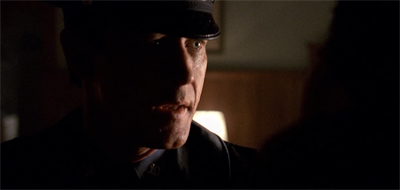
Beating the rap…
In many respects, this is just a reflection of a broader culture shift in how people talk to one another and about one another. The anger directed towards television shows and feature films is not too different from that directed towards public officials who are perceived to have stepped out of line. As Julia Turner observes:
Over the past decade or so, outrage has become the default mode for politicians, pundits, critics and, with the rise of social media, the rest of us. When something outrageous happens—when a posh London block installs anti-homeless spikes, or when Khloé Kardashian wears a Native American headdress, or, for that matter, when we read the horrifying details in the Senate’s torture report—it’s easy to anticipate the cycle that follows: anger, sarcasm, recrimination, piling on; defenses and counterattacks; anger at the anger, disdain for the outraged; sometimes, an apology… and on to the next. Twitter and Facebook make it easier than ever to participate from home. And the same cycle occurs regardless of the gravity of the offense, which can make each outrage feel forgettable, replaceable. The bottomlessness of our rage has a numbing effect.
This is arguably facilitated by advances in communications technology. It was a lot harder to find a self-reinforcing circle of hate in the old pen-and-paper days; it took work to build up passive-aggressive fanzines. But it did happen. Just ask Colin Baker. However, the internet age makes it as simple as firing up the computer.

That’s ketchup. All the tough guys get in prison food fights.
The internet tends to favour extreme positions for a variety of reasons, ranging from anonymity to the difficulty of moderating tone in the written word. As ever, The Simpsons seemed to have its fingers on the pulse with a prescient (and still timely) gag about how Springfield’s resident Comic Book Guy would aggressively label everything as “worst [noun] ever.” It was a gag that was hilarious when first employed in The Itchy and Scratchy and Poochie Show back in February 1997, but which seems more astute as time goes on.
Indeed, the ninth season of The X-Files would itself engage with that on-line backlash in a number of ways. Scary Monsters would feature the return of fan surrogate Leyla Harrison, who would constantly complain about how Doggett and Reyes were nowhere near as good as Mulder and Scully. Afforded the chance to wrap up the story arcs of the Lone Gunmen, writers Frank Spotnitz, Vince Gilligan and John Shiban would brazenly title the episode Jump the Shark in a none-too-subtle jab at a certain school on on-line television commentary.

Kill al the lawyers, eh?
Of course, these responses would serve to further entrench that vocal fan reaction to the ninth season. There was a sense that the relationship between the production team and the fans had somewhat soured over the past couple of seasons, and that there was a lot of frustration on both sides. There are points during the ninth season where The X-Files feels quite bitter and toxic, an air of palpable frustration apparent in both the episodes themselves and the responses to those episodes.
The problem with internet outrage culture is quite clear. There is no room for moderation or equivocation. Everything is either brilliant or terrible, nothing tends to fall in between. Once a piece of pop culture has been identified as flawed, a dogpile can then form; any attempt to moderate that criticism is seen as apologism, any attempt to play devil’s advocate is rejected as insanity. There are points where it feels like there are no acceptable opinions beyond those shouted at the loudest volume.
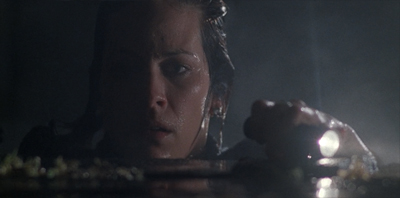
There’s a flush joke in here, but I don’t have the strength…
Underneath is not a good episode of The X-Files. It is bland and generic, derivative and half-formed. However, it is not the worst episode the show ever produced. It is not the worst episode that John Shiban ever scripted, by a considerable margin. It is not even the worst episode of the season. It is flawed, clumsy, forgettable. It is not a monstrosity. As such, the reaction to it – and the way in which that reaction was trumpeted and amplified – feels excessive. Had it aired in an earlier season, it would be entirely unremarkable.
John Shiban is not the strongest writer on the writing staff. In terms of X-Files writers, Shiban is notably primarily for his longevity. Shiban joined the staff in the third season, and remained on the show through to the bitter end. Shiban worked on The X-Files longer than Glen Morgan, James Wong, Darin Morgan or Howard Gordon. He was part of the production team that oversaw The Lone Gunmen, and he received an Emmy nomination for his work on Memento Mori. Shiban has staying power.

Dude cleans up good.
However, Shiban was never going to be a breakout performer on The X-Files. Then again, it is worth putting that in context. Glen Morgan and James Wong created the Final Destination series and adapted Intruders, Vince Gilligan created Breaking Bad and Better Call Saul, Frank Spotnitz has been responsible for Kolchak, Hunted and The Man in the High Castle, and Howard Gordon was a major influence on 24 and Homeland. With all of that talent, “breakout performer” has a very high threshold.
Shiban was generally reliable as far as writers go. He was a writer that Chris Carter could trust to produce a couple of solid teleplays in a year. That sounds like faint praise, but it is worth considering just how many writers came and went in the early years of the show. Carter has talked about the difficulty of finding writers he trusted to script for the show. It seems fair to suggest that Shiban was one of the few who could be consistently relied upon to turn in a filmable script on time. With the hectic schedule of television, that is just as essential as visionary talent.
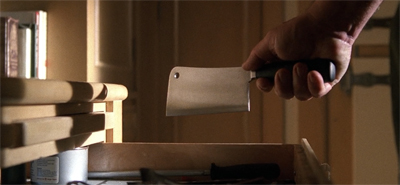
Hackin’ away…
Shiban could write a solid X-Files episode, but he was less likely to crack out a great (or even a good) episode. Shiban’s scripts tend to be among the weaker instalments of the show. Shiban’s name is on Teso dos Bichos, El Mundo Gira and Badlaa. Shiban was much less likely to churn out a classic than Vince Gilligan or Frank Spotnitz. His best solo scripts are the first half of Elegy and The Pine Bluff Variant. His best work tended to be with other writers – Monday and Field Trip with Vince Gilligan, Theef with Vince Gilligan and Frank Spotnitz.
This is the context in which Underneath should be judged. It is a script credited to Shiban, and Shiban alone. As a result, it is likely to fit with the pattern of the rest of his work. It is a bunch of familiar horror story beats thrown together, relying more on atmosphere than on logic. Underneath is certainly not the worst script credited to Shiban, even if it lacks the energy and dynamism that mark the best episodes of this troubled ninth season. It is competent and efficient, even if it is not particularly good.
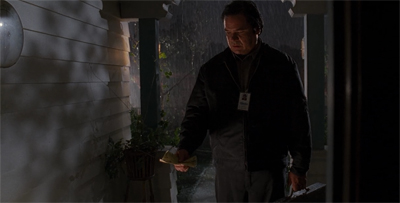
Working it out…
Underneath is notable as Shiban’s directorial debut. The writer was following in the footsteps of other X-Files writers-turned-directors, like Chris Carter on Duane Barry or James Wong on Musings of a Cigarette-Smoking Man or Vince Gilligan on Je Souhaite or Frank Spotnitz on Alone. It was a tough assignment:
The episode was Shiban’s directing debut, and proved to be “one of the hardest things I had to do on The X-Files. The first day of directing was hard but once I got through that, I had a blast. It’s like a giant toy store. You do all kinds of amazing things and you have a talented crew who follow your every whim. It’s a ball.”
In many respects, it is Shiban the director who disappoints. Shiban’s scripts tend to draw on pulpy horror sensibilities, putting a lot of onus of the tone and atmosphere established by the director. Rob Bowman was a huge part of the appeal of The Walk and The Pine Bluff Variant.

“What can I say? It went through A LOT of re-writes…”
Underneath is competent, but it is fairly bland. There are no truly memorable shots, no particularly effective set pieces. This is not necessarily a problem of itself; Frank Spotnitz’s direction of Alone was fairly routine, but that episode benefited from a warm script and some nice character beats. In contrast, the script to Underneath is packed to the brim with familiar clichés and stock storytelling choices. It is possible that Rob Bowman, David Nutter or Kim Manners might have made it interesting. Shiban simply does not have the skillset yet.
Underneath feels very familiar on a number of levels. The basic premise of the episode centres around a character who undergoes a literal transformation due to their repression. It is a change so fundamental that the character’s DNA is altered. When Reyes suggests that the killer is a result of the suspect’s repression, Doggett responds, “But it wouldn’t explain the DNA evidence.” Reyes replies, “It would if he physically became that other personality.” Doggett is skeptical. “We’ve moved on from Casper the Friendly Ghost to Doctor Jekyll and Mister Hyde?”
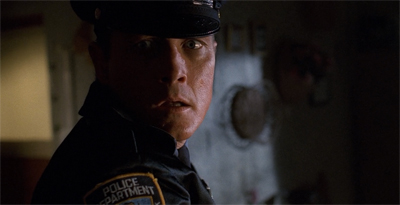
That old New York feelin’…
If this plot point feels familiar, it should. David Amann wrote a much superior “character suppresses their emotions so much that they transform into a different person who is also the killer” plot late in the seventh season with Chimera. To be fair, The X-Files has been running for nine seasons, it is inevitable that occasional plots might be recycled. However, this is not just a basic plot; this is the exact same monster, just warmed up and served as an X-Files leftover.
In Chimera, David Amann suggested that this repression was a response to the pressures of suburban life; the monster was a manifestation of all those horrible feeling that had to be buried beneath the dishonest smiles and pleasant veneers. Shiban at least comes up with a slightly different explanation in Underneath. It turns out that Robert Fassl has actually created a monster from his sense of Catholic guilt. It is a certainly an interesting angle, given the show’s larger engagement with religious issues, particularly in the wake of 9/11.

Blood money.
“What if a man of profound faith, a devout Catholic, was incapable of contrition?” Reyes speculates, demonstrating Mulder’s remarkable ability to jump to the craziest possibility and still be correct. “What if he were so frightened by it that he couldn’t even admit it to himself? Might not someone like that manifest a second personality?” Later, Reyes likens it to transubstantiation – “the manipulation of matter and energy.” It is a fairly intriguing concept, even if it feels like the ninth season already did “repression equals paranormal murder” in 4-D.
Catholic guilt is a fascinating concept, even if its existence is subject to debate. Studies suggest that Catholics are no more or no less susceptible to feelings of guilt than members of other denominations, although there is some suggestion that religious individuals generally feel more guilt than non-religious individuals. Nevertheless, the concept of Catholic guilt lingers in popular culture, what Jack Donaghy describes as simply the “crushing guilt that comes with being a Catholic.”
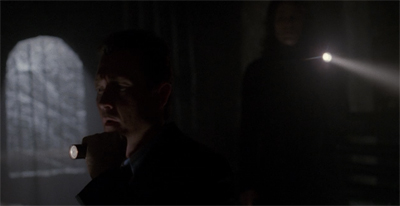
Going deeper underground… er, underneath.
There are interesting and diverse stories that can be told using this device. Indeed, the entire first season of Daredevil plays as an extended metaphor on issues related to Catholic guilt. This seems entirely appropriate given Frank Miller’s reflection that “only a Catholic could be both an attorney and a vigilante.” In a way, this is the core idea of Underneath, the idea that – to borrow Miller’s logic – only a Catholic could be an innocent man and a brutal murderer at the same time.
The problem is that Underneath has absolutely nothing interesting to say on the topic. Shiban fixates upon Fassl’s rosary beads and offers shots of him preying, but there is a minimal amount of actual commentary or engagement. Underneath was airing a few months after The Boston Globe published a number of high-profile exposés about systemic cover-ups of child abuse by the Catholic Church in Boston. Those reports started a tidal wave of press coverage and investigations into child sex abuse.
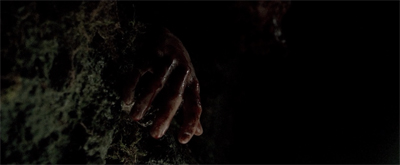
Recognising his own handiwork…
Underneath feels like an episode that should connect to those revelations in some way, to the gulf between religious piety and horrific behaviour. These ideas and these themes would bubble over into the wider debate about a connection between celibacy and clerical sex abuse. Theologian Hans Küng argues it is all part of a larger context:
Although there is no question that abuse also occurs in families, schools, and youth organizations, as well as in churches that do not have the rule of celibacy, why are there such an extraordinary number of cases specifically in the Catholic church, whose leaders are celibate?
Of course, celibacy is not solely responsible for these crimes. But it is the most important structural expression of the Catholic hierarchy’s inhibitions with regard to sexuality, evident also in its attitude toward birth control and other questions.
Repression is inherently harmful and toxic. Underneath seems to touch on these ideas, but lacks the necessary nuance or sophistication to make a convincing argument one way or the other. It feels very much like a missed opportunity, an episode making gestures towards meaningfulness or complexity.

Man of faith…
The rest of the script is just as obvious, populated by cringe-worth sign-posting and awkward dialogues. Shiban painstakingly sets up just about all of the episode’s plot developments ahead of time, to the point that there are no surprises to be found. When Doggett refers to his former partner as “a man [he respects] deeply”, it becomes all but inevitable that the pedestal will be broken and that his partner will be exposed as “a liar, a felon.” This is the level of subtlety at which Underneath is operating.
It is not enough to imply that Doggett might have his own subconscious motivations for his pursuit of Fassl – reasons underneath his justifications, if you catch the script’s meaning. Instead, Scully actually articulates that reading. “I just… I just worry that maybe this is about you feeling guilty,” she states. Doggett actually earnestly replies, “Like what, subconsciously?” This is very blunt dialogue, dialogue that seems to be written so that even the kids at the back can keep up with the subtext can keep up – themes underneath the plot, if you catch the script’s meaning.
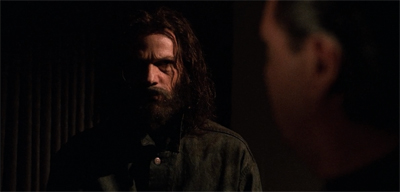
Talkin’ to the man from Galilee…
It all builds to a climax in the sewers – spaces underneath the street, if you catch the script’s meaning. Underneath is not afraid to keeping hitting its audience over the head until it is absolutely certain that they understand the themes. It then hits them again, to be sure. Perhaps the smartest idea in the entirety of the episode is the design of Fassl’s murderous alter ego. Doggett describes him as Fassl’s “Charlie Manson sidekick”, but he also bears an uncanny resemblance to Jesus Christ in the most provocative choice of the entire episode.
Sadly, this is the only remotely clever idea playing out in Underneath. It feels like Shiban picked up the episode’s cast at some a discount archetype score. Crooked cop and fallen hero? Check. Liberal defense attorney who unwittingly welcomes a monster into her house? Check. Cynical and bitter District Attorney with no care about the greater good? Check. Just in case the “lawyers are terrible” subtext is a bit too subtle, Shiban has his weaselly District Attorney actually assert “if we can’t get a conviction, then the truth doesn’t matter.”
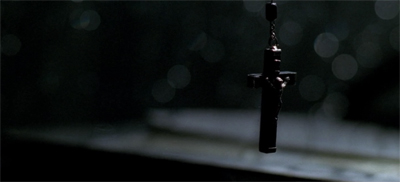
This is going to get crucified…
Perhaps the most notable aspect of Underneath is that it introduced guest star W. Earl Brown to screenwriter Shane Black. Part of the episode was shot in Shane Black’s house, as Brown recalls:
And I met Shane Black there. Shane Taylor, my partner on Bloodworth, his mentor was Shane Black. We shot in Shane Black’s house. We’re in this house in Hancock Park—really nice house. And I’m in the library, and there are all these first-edition comics, like The Shadow. Really fucking expensive comics just lying there. And I see these shelves with all these first-edition books and these comics and I go, “Whose house is this?” “Oh, the screenwriter, Shane Black.” As we’re shooting, he just comes wandering in, in his house robe. That was in his fallow period, where he didn’t write for three or four years. I was like, “You wrote Lethal Weapon!” [Laughs.] “You’re the highest-paid writer in Hollywood.” He’s just wandering through his house in a bathrobe: “How you guys doing? What’s this scene about?” I brought it up when Shane Taylor introduced me to him. He goes, “It’s nice to meet you.” I said, “Actually, I’ve been in your house.”
It is a nice little anecdote, one that makes perfect fodder for a Shane Black or X-Files table quiz and a solid addition to any “six degrees of separation” trivia.
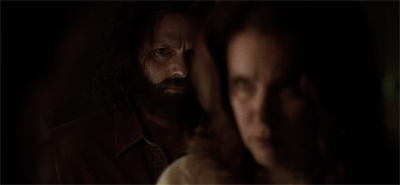
“You never wash down the sink!”
Shane Black trivia aside, Underneath is all very rote and familiar. The X-Files has done all of this before, and better. Underneath is not a satisfying hour of television. But it is far from the worst thing that show has ever done. The amount of hatred that arguably says more about the broader attitude towards The X-Files than it does about the episode itself.
Filed under: The X-Files | Tagged: discourse, extreme reactions, fan culture, internet, john shiban, outrage culture, the x-files, worst episode ever, x-files |




















I hated Underneath for many years, putting at the bottom of my list, even below the abysmal Fight Club (at least that episode had the chemistry of DD and GA). Upon rewatching it yesterday, I found it more enjoyable. Robert Patrick does a good job with the limited material he’s given. As does W. Earl Brown. And the episode has one of the darkest aesthetics of the season, giving it a creepy vibe in parts. But Darren is right, its been done before and better. I came here expecting you to praise the episode, Darren (you’re reviews have helped me to see some episodes in a better light, especially in seasons 7 and 9) but am glad we’re on the same page. It’s no longer my least favourite episode but it would struggle to get into my top 175. Good review.
Thanks Andrew! I’m fairly conventional in my tastes, I think. But I am quicker to forgive than most.
My issue with the episode was how quickly they let the killer out. He was found at the crime scene for no legitimate reason converted with blood and presumably holding the murder weapon, while they don’t literally see him in the act it’s weird that no one even questions him to see if he saw someone else at the scene. Also if the other cop planted the fassil’s hair at the scene then why was the hair of his alter ego? I really liked the cold open of this episode but everything was so route and nonsensical that I couldn’t enjoy it past that.
I think the whole thing is just a mess. I don’t think it’s as bad as the production leaks made it seem, but it is pretty bad.
I like the point you made here about John Shiban as a writer. He seems to be on the opposite end from Darin Morgan, a brilliant writer who couldn’t produce much in a season. Shiban is a decent writer who could still more frequently get content in front of a camera. Given television is a business and broadcast slots need to be filled, having a writer like Shiban matters, just as having a writer like Morgan matters. Too often, emphasis is put on being spectacular at something in order to succeed. Shiban is an example of how it’s possible to be quite successful without being phenomenal.